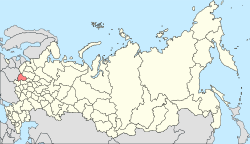Vyazma
| Vyazma (English) Вязьма (Russian) |
|
|---|---|
| - Town - | |
 In Vyazma |
|
 Location of Smolensk Oblast in Russia |
|
|
|
|
|
|
|
|
|
|
| Administrative status (as of February 2014) | |
| Country | Russia |
| Federal subject | Smolensk Oblast |
| Administrative district | Vyazemsky District |
| Urban settlement | Vyazemskoye |
| Administrative center of | Vyazemsky District, Vyazemskoye Urban Settlement |
| Municipal status (as of December 2011) | |
| Municipal district | Vyazemsky Municipal District |
| Urban settlement | Vyazemskoye Urban Settlement |
| Administrative center of | Vyazemsky Municipal District, Vyazemskoye Urban Settlement |
| Statistics | |
| Area (urban settlement) (February 2014) | 48.58 km2 (18.76 sq mi) |
| Population (2010 Census) | 57,101 inhabitants |
| - Rank in 2010 | 288th |
| Density | 1,175/km2 (3,040/sq mi) |
| Time zone | MSK (UTC+03:00) |
| First mentioned | 1230 |
| Postal code(s) | 215110, 215111, 215113, 215116, 215118, 215119, 215125, 215129, 215169 |
| Dialing code(s) | +7 48131 |
|
|
|
| on | |
Vyazma (Russian: Вя́зьма) is a town and the administrative center of Vyazemsky District in Smolensk Oblast, Russia, located on the Vyazma River, about halfway between Smolensk, the administrative center of the oblast, and Mozhaysk. Throughout its turbulent history, it defended western approaches to Moscow. Population: 57,101 (2010 Census);57,545 (2002 Census);59,022 (1989 Census); 44,000 (1970).
Vyazma was first mentioned in a chronicle under the year of 1230, although it is believed to be much older than that. The town was named after the river, whose name was from Russian word "вязь" (vyaz'), meaning "bog" or "swamp". At the time, the town belonged to a lateral branch of the Rurikid House of Smolensk. In 1403, the local princes were expelled by Lithuanians to Moscow, where they took the name of Princes Vyazemsky. The most notable among them were Pyotr Vyazemsky, an intimate friend of the poet Alexander Pushkin and a poet himself, and Sophie Viazemski, a French writer, for a time married to Jean-Luc Godard.
In 1494, Vyazma was captured by the Grand Duchy of Moscow and turned into a fortress, of which but a single tower remains. Two important abbeys were embellished with stone churches, including a rare three-tented church dedicated to Our Lady of Smolensk (Hodegetria) and consecrated in 1638 except Polish occupation between 1611–1634. A barbican church of the same abbey dates back to 1656, and the town's cathedral was completed by 1676. Other churches are designed mostly in baroque style.
...
Wikipedia



